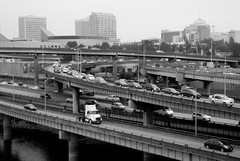
during his presentation yesterday.
(Photos: Adams Carroll/BikePortland)
About 60 people gathered in the Portland Building last night to hear professor and former Vancouver B.C. city councilor Gordon Price share his insights on transportation, land use, and urban planning. Price’s presentation, which was part of the traffic and transportation course at Portland State University, detailed the problems of auto-centric planning in North America and offered some practical solutions from Vancouver.
Vancouver, a city that Price labeled ‘post-motordom’… The downtown population has doubled in ten years while the rate of car trips has decreased over the same period.
Price began his lecture focusing on the achievements of ‘motordom,’ an early twentieth-century coalition of auto businesses and interest groups who managed to bring about a “social reconsideration of the street.” At a time when most people got around on bicycles, streetcars, or by foot, these auto advocates succeeded in re-purposing streets primarily for car travel.
The pinnacle of motordom, Price said, was the creation of the interstate highway system, which allowed drivers to travel coast-to-coast without ever seeing a red light. Price also explained how our system is now being mimicked by China, a country with aspirations to build a 50,000 mile system even larger than our own. Although highways have never solved the problem of congestion – “efficient, free rapid flow of automobile traffic can’t even work on its own terms,” said Price – they have created a host of other problems.

Price said that proponents of motordom realized there was a simple way to make the car succeed: “Get rid of the cities.” Thus, our trajectory toward sprawl was set. But, Price added, this isn’t about being anti-car. “Motordom is not about the car, it’s about what the car makes possible: auto dependent urban form… the problem isn’t cars, it’s that we overdid it, drove out choice… we’ve made ourselves vulnerable.”
A proponent of dense, thoughtful development, Price called in to question traditional congestion mitigation solutions, asking his audience, “where is there a good example of an urban region that successfully dealt with traffic congestion by building more roads and bridges?” According to Price, the best way to solve the problem of congestion is to isolate it to bridges and highways while developing the appropriate densities and facilities needed to support transit, cycling, and walking in urban areas.
These solutions have been effective in Vancouver, a city that Price labeled ‘post-motordom.’ Vancouver has left the vibrant urban villages created by its original streetcar network intact, adapting them to support twenty first century population growth. The city’s downtown population has doubled in ten years while the rate of car trips has decreased over the same period.
Portland stands to learn much from Vancouver’s achievements, but also faces additional challenges.
Unlike Vancouver, Portland has major highways running through its urban core that feed congestion into the city’s grid and enable sprawl in suburban neighbors like Vancouver, Washington. Price, however, believes that the days of the suburb are numbered. Peak oil and the global financial crisis are “radical, unexpected changes” that have eliminated the cheap energy and land necessary for suburban growth. As a result, we can expect to see more suburbs reconfiguring themselves after an urban model, especially by redeveloping expansive parking lots into dense, mixed used neighborhoods*.
[*This is already happening in inner Portland neighborhoods. For example, The Oregonian reported this week about a new apartment development on N. Mississippi Ave. where 70% of tenants do not own a car.]
Price said that a specific challenge of the Portland Plan (which is holding a series of public workshops through December) should be to determine how to reallocate the space left behind by auto-centric infrastructure in the wake of the diminishing use of cars. He also suggested that serious accommodation of cyclists should be a high priority and pointed out his concern that the Portland Plan’s focus on “20 minute neighborhoods” doesn’t quite ring true. “That’s too much time,” he said.
In the past month, we’ve heard loud and clear from visiting experts that it’s time for Portland to focus on the elephant in the room — cars. From a European business expert, politician, advocate and engineer working in cities our Bureau of Transportation says they want to emulate, to a marketing expert who has done work for the City of Copenhagen, the message has been loud and clear: Building bikeways will only get us so far, we must begin to institute policies that discourage automobile use.
We know our city bureaucrats and elected officials have heard this message, the question now is, when will they start to heed the advice?
Gordon Price is the director of the City Program at Simon Fraser University and the author of Price Tags, an e-magazine on urban issues, and a blog of the same name.


